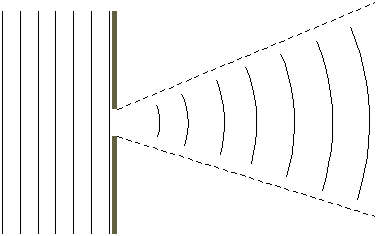Kinds of Wave Propagation
Refraction
When the wave enters the new medium, the speed of propagation will change.
In order to match the incident and transmitted wave at the boundary, the transmitted
wave will change its direction of propagation. For example, if the new medium has
a higher index of refraction, which means the speed of propagation is lower, the
wavelength will become shorter (frequency must stay the same because of the boundary
conditions). For the transmitted wave to match the incident wave at the boundary,
the direction of propagation of the transmitted wave must be closer to perpendicular.
Reflection
When a plane wave encounters a change in medium, some or all of it may propagate
into the new medium or be reflected from it. The part that enters the new medium is
called the transmitted portion and the other the reflected portion. The part which
is reflected has a very simple rule governing its behavior.

Diffraction
Recall that the idealized plane wave is actually infinite in extent. If this
wave passes through an opening, called an aperture, it will diffract, or spread out,
from the opening. The degree to which the cropped wave will spread out depends on
the size of the aperture relative to the wavelength. In the extreme case where the
aperture is very large compared to the wavelength, the wave will see no effect and
will not diffract at all. At the other extreme, if the opening is very small, the
wave will behave as if it were at its origin and spread out uniformly in al
directions from the aperture.

Resouce/s:
Retrieve from:
https://fas.org/man/dod-101/navy/docs/es310/propagat/Propagat.htm
Refraction
When the wave enters the new medium, the speed of propagation will change.
In order to match the incident and transmitted wave at the boundary, the transmitted
wave will change its direction of propagation. For example, if the new medium has
a higher index of refraction, which means the speed of propagation is lower, the
wavelength will become shorter (frequency must stay the same because of the boundary
conditions). For the transmitted wave to match the incident wave at the boundary,
the direction of propagation of the transmitted wave must be closer to perpendicular.
Reflection
When a plane wave encounters a change in medium, some or all of it may propagate
into the new medium or be reflected from it. The part that enters the new medium is
called the transmitted portion and the other the reflected portion. The part which
is reflected has a very simple rule governing its behavior.
Diffraction
Recall that the idealized plane wave is actually infinite in extent. If thiswave passes through an opening, called an aperture, it will diffract, or spread out,from the opening. The degree to which the cropped wave will spread out depends onthe size of the aperture relative to the wavelength. In the extreme case where theaperture is very large compared to the wavelength, the wave will see no effect andwill not diffract at all. At the other extreme, if the opening is very small, thewave will behave as if it were at its origin and spread out uniformly in aldirections from the aperture.

No comments:
Post a Comment